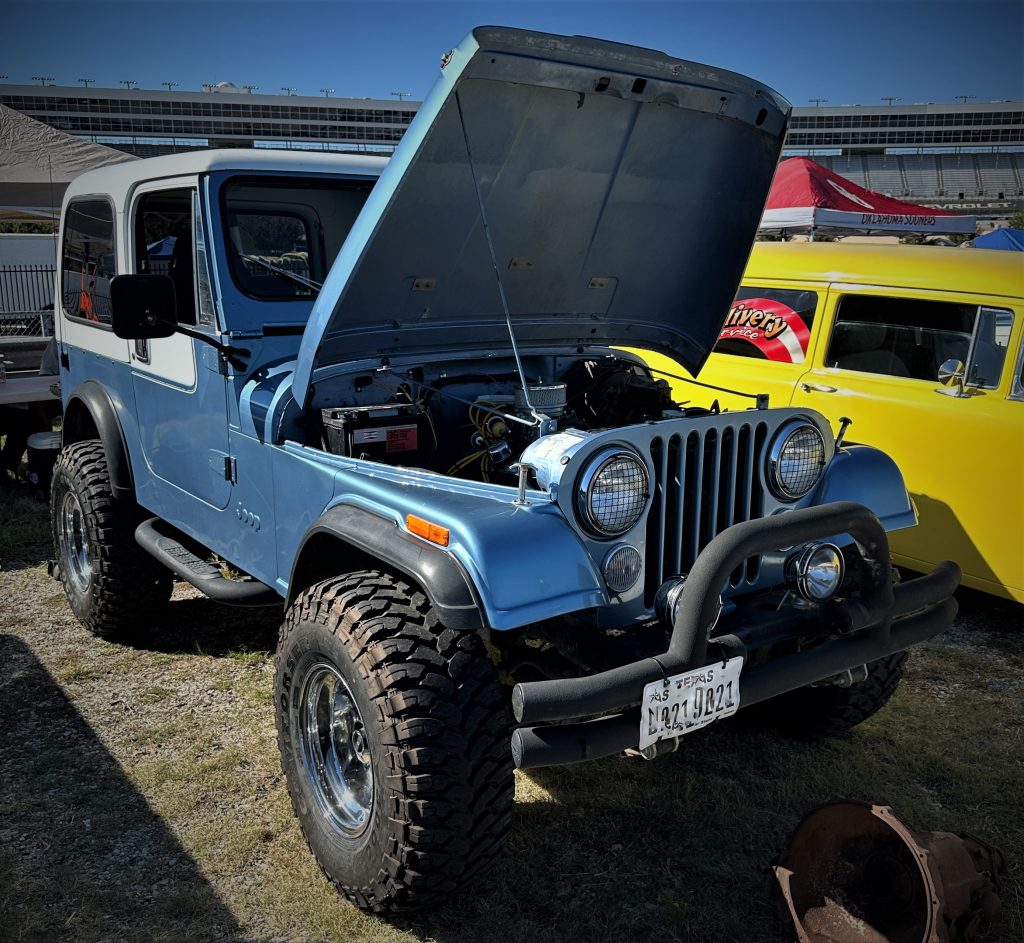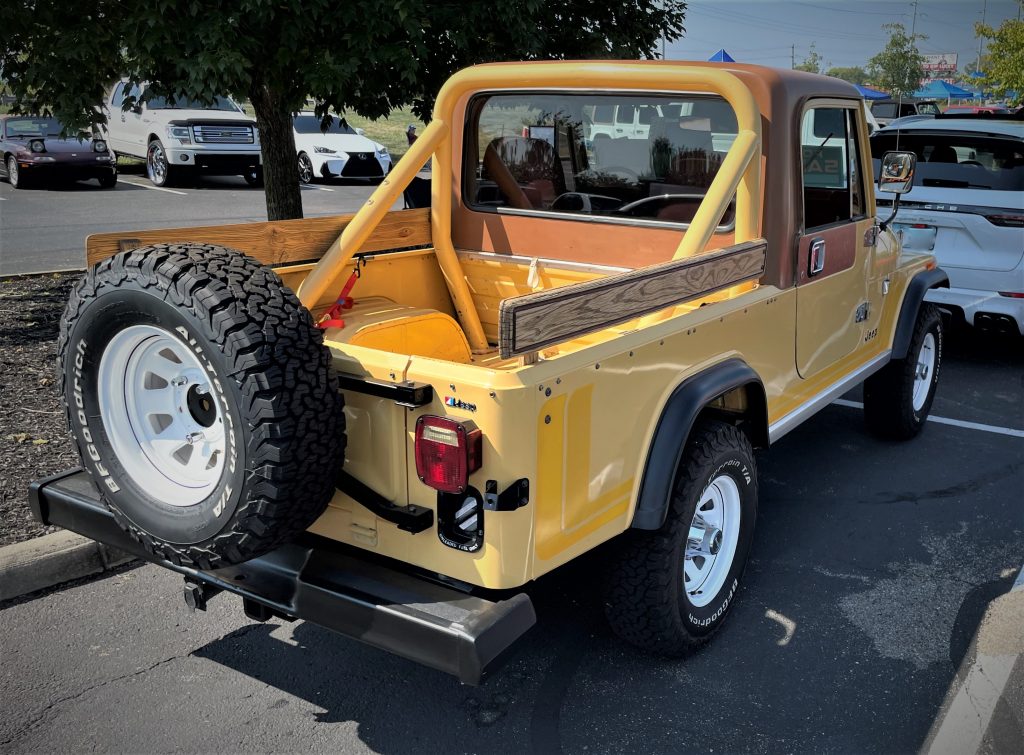Here’s a comprehensive spotter’s guide to help you identify each production Willys and Jeep CJ model.
Pre-dating the modern Jeep Wrangler by several decades, the Civilian Jeep (aka CJ or “Universal” Jeep) lineage can be traced back to the Willys MB/Ford GPW military trucks of World War II. And the commercial success of these early 4x4s are the reason we’re still enjoying open-top off-roading to this day.
As you’d expect over the 40ish years of CJ production, there were several distinct generations and they weren’t always perfectly sequential. So we’re going to break down the most prominent CJ models below to give you some clues to look for.
Jeep CJ Identification Guide
***
Jeep CJ-2A (1945-49)

First off, let’s explain why this list starts with the CJ-2A and not, bewilderingly, CJ-1 or even CJ-2.
That’s because, for all intents and purposes, the CJ-2A was the first mass-produced Civilian Jeep. While records are scarce, the few CJ-1s that were made existed only as proof-of-concept vehicles and summarily scrapped. The CJ-2 that followed was built in very small numbers for testing purposes and not sold to the public.
Hence why, when the production model hit the scene in 1945, it was dubbed the CJ-2A.

Originally called the “AgriJeep,” the CJ-2A was marketed to folks like farmers, linemen, and ranch hands. Produced right alongside its military-spec cousin, the Willys MB, the CJ-2A had some more commercially-friendly features like a tailgate and the requisite side-mount spare.

***
Jeep CJ-3A (1949-53)

Look, if the whole CJ-1/CJ-2 thing didn’t confuse you, wait until you find out there were two CJ-3s.
And it starts with the CJ-3A. Now don’t be alarmed if you can’t immediately spot the difference between a Jeep CJ-3A and the earlier CJ-2A, because the updates are subtle. First off, notice the one-piece windshield glass, replacing the dual-section windscreen on the CJ-2A.
The rest of the CJ-3A updates were far less conspicuous, and included things like more comfortable seats and increased legroom. The suspension was also modified to accommodate the enhanced use of the Jeep’s Power Takeoff (PTO) drive to run implements like sawmills, water pumps, and auger drills.

***
Jeep CJ-3B (1953-68)

OK, well at least it’s pretty easy to tell a 3A from a 3B. With its unmistakable raised cowl and elongated grille, CJ-3Bs got the nickname “high hoods.” The revised design was necessary to cram in the Willys Hurricane engine, which was quite a bit taller than the outgoing powerplant.
The Hurricane was an evolution from the flathead “Go Devil” four-cylinder engine that propelled earlier CJ models. While still a four-banger, the Hurricane’s new overhead valve architecture improved flow and was good for around 75 horsepower, which was about a 15 hp bump from the previous Go Devil motor.

It’s worth pointing out that the CJ-3B marked the first CJ produced after the Willys-Overland company was purchased by Kaiser Motors. Kaiser stripped away the “Overland” part of the name, and continued to market the Jeep as a Willys model. You may also notice that CJ-3B production overlaps with both CJ-3A and CJ-5. That’s largely because, even after the CJ-5 (M38A1) was introduced, the CJ-3B’s military variant, the M606, soldiered on until the end of the 1960s—though it was primarily destined for export markets.
***
Jeep CJ-5 (1955-83)

Wait, what happened to the CJ-4?
Alright, technically there was a CJ-4 test prototype that sort of blended the nascent CJ-5’s body tub with the flat fenders of the earlier Jeeps. But that design ultimately evolved into what you see here. That generational skip paid off though, as the CJ-5 holds the distinction of the longest production run of any CJ model.
Perhaps the most obvious styling trait of the CJ-5 is its rounded front fenders that prevent muck from being flung forward off the tires. Those fenders, along with the new grille design, became the template for all other CJ Jeeps from here on out.

Over the course of its impressive production stretch, the CJ-5 can be broken into a trio of sub-generations, largely thanks to Jeep’s parent company changing hands from Kaiser to AMC in 1970, along with some evolving safety regulations and fuel economy demands.
“Early” 1954-69 Jeep CJ-5s can be identified by the nearly vertical windshield and gas tank under the driver’s seat, which located the fuel filler neck in a distinctive pocket panel behind the driver (see the blue CJ-5 above).
Then in 1970, CJ-5s had their gas tanks relocated to the rear. Curiously, to save on retooling costs, AMC let the filler’s tub stamping remain—you can see the blank panel where the filler neck once was on the green CJ-5 below.

While it could technically begin as early as 1970, many folks say the CJ-5’s “Intermediate” era was between 1972 and 1975, during which the CJ’s wheelbase, hood, and front fenders were stretched to accommodate AMC’s longer inline six engines, the 232 and 258—the latter 258ci I6 would ultimately evolve into the legendary 4.0L six that propelled Wranglers into the 21st century. The 1972 CJ-5 also marked the first time you could get a CJ with a V8, specifically AMC’s trusty 304.
Finally in 1976, the “Late” CJ-5 got its last significant upgrades, and it included a change in the windshield pitch and design, along with a boxed frame and disc brakes.
1976 also brought the introduction of the CJ-7, but before we go there…
***
Jeep CJ-6 (1956-75)

If there’s an odd duck sitting in the Jeep CJ family tree, it might just be the CJ-6. But we don’t mean that in a bad way—on the contrary, thanks to limited domestic production, the CJ-6 is now prized by Jeep collectors. While its elongated body tub look peculiar to the uninitiated, the CJ-6 was far more versatile than its CJ-5 counterpart for a lot of applications, and it found roles with park services, rural fire departments, and a host of utility outfits.
The CJ-6 was about 20 inches longer than an ordinary CJ-5, but the two shared plenty of parts, specifically in the area of drivetrain and chassis. Despite the CJ-6’s commercial appeal, the model was dropped (in America, at least) in preparation for the arrival of the heralded CJ-7.
***
Jeep CJ-7 (1976-86)

From Ernest Borgnine to Catherine Bach, the Jeep CJ-7 has a lot of fans. And it’s easy to see why. The CJ-7 addressed the biggest gripes folks had about the CJ-5: comfort, handling, and versatility.
For starters, the CJ-7’s body tub is longer than the CJ-5’s, allowing for several precious cubic feet of cargo space behind the seats. Its additional 10 inches of wheelbase over the CJ-5 also meant it was more stable at highway speeds. As the model evolved, the CJ-7 (and CJ-5) added wider track axles to further improve handling.

Then there was the hardtop.
Though earlier CJs had steel hardtops available, they were typically big, heavy, and difficult to remove. The CJ-7’s new molded plastic hardtop was lighter and easier to pop off for summer driving. Combine that with the CJ-7’s new optional steel doors, and it made for a far more comfortable, quieter ride.
There were other feature upgrades too, like (gasp!) an available automatic transmission and modern (for the era) full-time all-wheel drive.

The CJ-7 was perhaps the first big pivot towards making the utilitarian Jeep a bit more mainstream, in an effort to appeal to a wider audience. And it worked too—Jeep sold nearly 400,000 of them in just over a decade, setting the stage for the upcoming Jeep Wrangler YJ.
***
Jeep CJ-8 (1981-86)

Marketed under the name Scrambler, the CJ-8 was Jeep’s way of jumping into the compact truck segment, which was heating up in the early 1980s with the upcoming arrivals of the new Chevy S-10 and Ford Ranger.
Borrowing from the CJ-6 recipe tested a few decades earlier, the CJ-8 is basically a longer wheelbase version of the CJ-7. It too had a removable half-cab hardtop and shared much of its drivetrain and chassis with the CJ-7—and the CJ-5, for that matter; don’t forget, it was still in production around this time as well.

But like AMC’s other innovative attempts to capture market share, the Scrambler came too little too late. American Motors was already in a tough financial spot, and had plans to develop the Cherokee-derived Comanche anyway, which meant the CJ-8’s days were numbered.
Its limited production means that the Scrambler is now a darling of the Jeep collectors market, and is often parked right alongside other bona fide classics at high-dollar auctions.
***
Bonus Jeeps: Export, Dispatcher, CJ-10 & Overlander Models
But that’s not the end of the CJ lineage! If we look outside the United States, you’ll find a vast web of export models and other Jeep-related vehicles produced under license by companies like Mahindra and Mitsubishi.
Take the CJ-10 for instance. It was a Jeep pickup truck bound for export markets, but a few CJ-10As were modified to remain stateside as aircraft tugs for major airports.

Then there is the Jeep Overlander. Produced in limited numbers primarily for the Australian market, these right-hand drive Jeeps are based on the CJ-8 platform, with a full-length steel hardtop known as the “World Cab.”
A close cousin of the Jeep Overlander is the CJ-8 custom-ordered by the Alaskan Post Office. The P.O. needed a rugged 4×4 with plenty of cargo room to deliver the mail in extreme conditions and it used RHD Scramblers equipped with modified World Cabs to do it.

Speaking of the Post Office, we should also quickly mention the CJ’s business-minded doppelganger, the Dispatcher. Dubbed DJ, the first Dispatcher Jeep appeared as a variant of the CJ-3A. These Jeeps featured two-wheel drive and an enclosed cabin, with the same rugged durability of the CJ—making them well suited for courier and delivery roles.
…But you probably know them better as “Mail Jeeps.”

***
We hope this little Jeep CJ history lesson helped. And if you’d like a wider look at the CJ’s evolution into the Wrangler family, check out our Jeep CJ & Wrangler Ride Guide infographic here.

[…] Source link […]
Great overview….i LOVE IT. ….thank you
The Australian overlander goes back to 1969 it was based on the cj6, and was built in Australia. This was in a article in jp magazine December 2019. I enjoyed your post,it was well done.
TY for such a thorough review. As a proud owner of a ‘94 YJ Sahara, I relish any historical info pertaining to the Jeep brand. This document is a real keeper!
JE (aka SQLITES)
[…] in addition to the original Wrangler. From 1996 to 2006, this film was made. While returning to the original CJ Jeep design cues, the TJ returned to its classic headlights and windshield […]